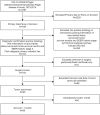Nomograms for predicting the prognosis of patients with penoscrotal extramammary Paget's disease: A retrospective study in the SEER database and two medical centers
- PMID: 36387106
- PMCID: PMC9647091
- DOI: 10.3389/fonc.2022.973579
Nomograms for predicting the prognosis of patients with penoscrotal extramammary Paget's disease: A retrospective study in the SEER database and two medical centers
Abstract
Background: Extramammary Paget' s disease (EMPD) is a rare cutaneous malignant tumor, and the prognostic factors associated with penoscrotal EMPD remains unclear. The purpose of this study is to investigate prognostic factors and construct nomograms to predict the outcome of patients with EMPD located in the penis or scrotum.
Methods: From the Surveillance, Epidemiology and End Results (SEER) database, we extracted 95 patients with primary EMPD located in the penis or scrotum as the training cohort. Forty-nine penoscrotal EMPD patients were included from two medical centers as the external validation cohort. Univariate and multivariate Cox regression model were applied to investigating risk factors of cancer-specific survival (CSS) and overall survival (OS). Based on the results of multivariate Cox regression analysis, the nomograms were constructed for predicting CSS and OS of patients with penoscrotal EMPD. The concordance index (C-index), receiver operating characteristic (ROC) curves and calibration curves were applied to evaluate the practicability and accuracy of the nomograms.
Results: In the training cohort, multivariate Cox regression analysis showed that marital status and tumor stage were independent factors of CSS, and marital status, tumor stage and surgery are associated with OS independently in patients with penoscrotal EMPD. Based on these results, we developed nomograms to predict CSS and OS respectively. The C-index values were 0.778 for CSS, and 0.668 for OS in the training set, which displayed the good discriminations. In the external validation set, the C-index values were 0.945 for CSS, and 0.703 for OS. The areas under the curve (AUC) values of nomogram predicting 1-, 3-, and 5-year CSS were 0.815, 0.833, and 0.861 respectively, and 0.839, 0.654, and 0.667 for nomogram predicting 1-, 3-, and 5-year OS respectively. In the validation set, the AUC values of nomogram predicting 1-, 3-, and 5-year CSS were 0.944, 0.896, and 0.896 respectively, and 0.777, 0.762 and 0.692 for nomogram predicting 1-, 3-, and 5-year OS respectively. Additionally, the internal calibration curves also proved that our nomograms have good accuracy.
Conclusions: By incorporating marital status, tumor stage and/or surgery, our nomograms can efficiently predict CSS and OS of patients with penoscrotal EMPD.
Keywords: SEER; external validation; nomogram; penoscrotal extramammary Paget’s disease; survival.
Copyright © 2022 Song, Zhou, Luan, Wang, Cao, Lu, Zheng, Wu and Lu.
Conflict of interest statement
The authors declare that the research was conducted in the absence of any commercial or financial relationships that could be construed as a potential conflict of interest.
Figures








Similar articles
-
Nomograms for predicting cancer-specific and overall survival in patients with invasive extramammary Paget's disease.Future Oncol. 2021 Jul;17(21):2785-2801. doi: 10.2217/fon-2021-0372. Epub 2021 May 14. Future Oncol. 2021. PMID: 33988031
-
Establishment and validation of nomogram models for overall survival and cancer-specific survival in spindle cell sarcoma patients.Sci Rep. 2023 Dec 27;13(1):23018. doi: 10.1038/s41598-023-50401-z. Sci Rep. 2023. PMID: 38155261 Free PMC article.
-
Establishment and validation of systematic prognostic nomograms in patients over 60 years of age with osteosarcoma: A multicenter external verification study.Cancer Med. 2023 Apr;12(8):9589-9603. doi: 10.1002/cam4.5736. Epub 2023 Mar 29. Cancer Med. 2023. PMID: 36992547 Free PMC article.
-
Analysis of prognostic factors of metastatic endometrial cancer based on surveillance, epidemiology, and end results database.Front Surg. 2023 Jan 6;9:1001791. doi: 10.3389/fsurg.2022.1001791. eCollection 2022. Front Surg. 2023. PMID: 36684133 Free PMC article. Review.
-
A New Online Dynamic Nomogram: Construction and Validation of a Predictive Model for Distant Metastasis Risk and Prognosis in Patients with Gastrointestinal Stromal Tumors.J Gastrointest Surg. 2023 Jul;27(7):1429-1444. doi: 10.1007/s11605-023-05706-9. Epub 2023 May 25. J Gastrointest Surg. 2023. PMID: 37231240 Review.
References
-
- St Claire K, Hoover A, Ashack K, Khachemoune A. Extramammary paget disease. Dermatol Online J (2019) 25(4):13030/qt7qg8g292. - PubMed
-
- Morris CR, Hurst EA. Extramammary paget disease: A review of the literature-part I: History, epidemiology, pathogenesis, presentation, histopathology, and diagnostic work-up. Dermatologic Surg Off Publ Am Soc Dermatologic Surg [et al.] (2020) 46:151–8. doi: 10.1097/DSS.0000000000002064 - DOI - PubMed
LinkOut - more resources
Full Text Sources

